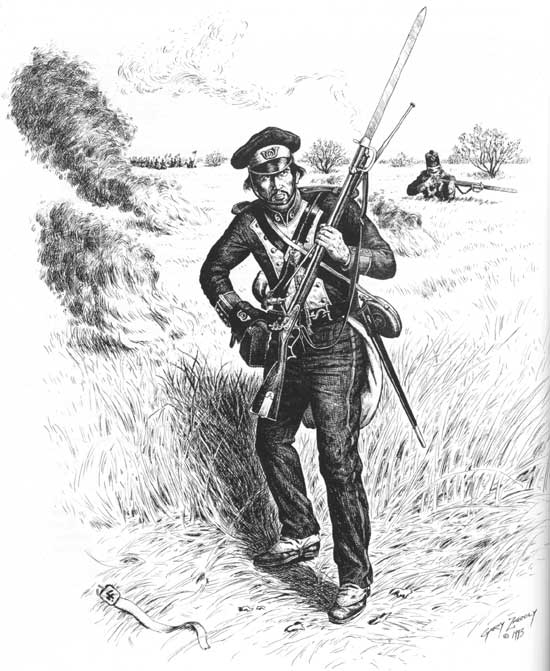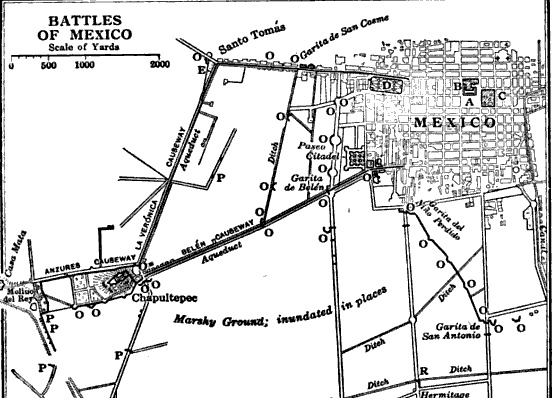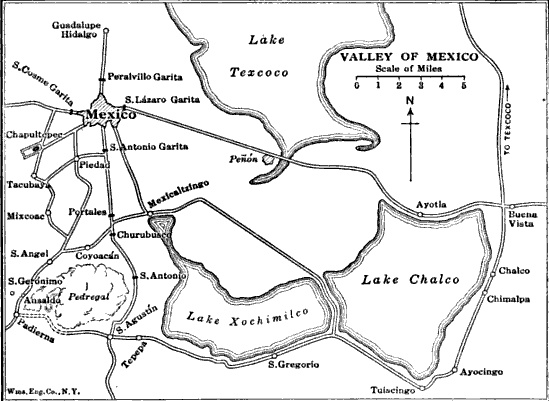|
Adam Gale Malloy
Adam Gale Malloy (September 10, 1830November 10, 1911) was an Irish American immigrant and Republican politician who served as a Union Army officer during the American Civil War. After the war, he was given an honorary brevet to brigadier general. He was an unsuccessful candidate for the United States House of Representatives from Texas in 1892. Early life Malloy was born on September 10, 1830, in County Tipperary, Ireland, then under the rule of the United Kingdom. He emigrated to the United States with his parents when he was still an infant. When he was 14, his father volunteered for service with the 4th U.S. Infantry Regiment, and Adam joined the regiment as a fifer (musician). At the outbreak of the Mexican–American War, the 4th U.S. Infantry was sent into battle in the Texas Campaign. Malloy's father was killed at the Battle of Resaca de la Palma, and during that battle Malloy took up a musket and became a combatant. He served through the remainder of th ... [...More Info...] [...Related Items...] OR: [Wikipedia] [Google] [Baidu] |
County Tipperary
County Tipperary ( ga, Contae Thiobraid Árann) is a Counties of Ireland, county in Republic of Ireland, Ireland. It is in the Provinces of Ireland, province of Munster and the Southern Region, Ireland, Southern Region. The county is named after the town of Tipperary (town), Tipperary, and was established in the early 13th century, shortly after the Norman invasion of Ireland. It is Ireland's largest inland county and shares a border with 8 counties, more than any other. The population of the county was 159,553 at the 2016 census. The largest towns are Clonmel, Nenagh and Thurles. Tipperary County Council is the local government in the Republic of Ireland, local authority for the county. In 1838, County Tipperary was divided into two Riding (country subdivision), ridings, North Tipperary, North and South Tipperary, South. From 1899 until 2014, they had their own county councils. They were unified under the Local Government Reform Act 2014, which came into effect following the 20 ... [...More Info...] [...Related Items...] OR: [Wikipedia] [Google] [Baidu] |
Battle Of Palo Alto
The Battle of Palo Alto ( es, Batalla de Palo Alto) was the first major battle of the Mexican–American War and was fought on May 8, 1846, on disputed ground five miles (8 km) from the modern-day city of Brownsville, Texas. A force of some 3,700 Mexican troops – most of the ''Army of The North'' – led by General Mariano Arista engaged a force of approximately 2,300 United States troops – the Army of Occupation led by General Zachary Taylor. On April 30, following the Thornton Affair, Mexican General Mariano Arista's troops began to cross the Rio Grande. On May 3, the troops began to besiege the American outpost at Fort Texas. Taylor marched his Army of Occupation south to relieve the siege. Arista, upon learning of his approach, diverted many of his units away from the siege to meet Taylor's force. The battle took place on May 8, three days before the formal declaration of war on Mexico by the United States. Arista ordered two cavalry charges, first against t ... [...More Info...] [...Related Items...] OR: [Wikipedia] [Google] [Baidu] |
Siege Of Vicksburg
The siege of Vicksburg (May 18 – July 4, 1863) was the final major military action in the Vicksburg campaign of the American Civil War. In a series of maneuvers, Union Maj. Gen. Ulysses S. Grant and his Army of the Tennessee crossed the Mississippi River and drove the Confederate Army of Mississippi, led by Lt. Gen. John C. Pemberton, into the defensive lines surrounding the fortress city of Vicksburg, Mississippi. Vicksburg was the last major Confederate stronghold on the Mississippi River; therefore, capturing it completed the second part of the Northern strategy, the Anaconda Plan. When two major assaults against the Confederate fortifications, on May 19 and 22, were repulsed with heavy casualties, Grant decided to besiege the city beginning on May 25. After holding out for more than forty days, with their supplies nearly gone, the garrison surrendered on July 4. The successful ending of the Vicksburg campaign significantly degraded the ability of the Confederacy t ... [...More Info...] [...Related Items...] OR: [Wikipedia] [Google] [Baidu] |
Vicksburg Campaign
The Vicksburg campaign was a series of maneuvers and battles in the Western Theater of the American Civil War directed against Vicksburg, Mississippi, a fortress city that dominated the last Confederate-controlled section of the Mississippi River. The Union Army of the Tennessee under Major General Ulysses S. Grant gained control of the river by capturing this stronghold and defeating Lieutenant General John C. Pemberton's forces stationed there. The campaign consisted of many important naval operations, troop maneuvers, failed initiatives, and eleven distinct battles from December 26, 1862, to July 4, 1863. Military historians divide the campaign into two formal phases: operations against Vicksburg (December 1862 – January 1863) and Grant's operations against Vicksburg (March–July 1863). Grant initially planned a two-pronged approach in which half of his army, under Maj. Gen. William Tecumseh Sherman, would advance to the Yazoo River and attempt to ... [...More Info...] [...Related Items...] OR: [Wikipedia] [Google] [Baidu] |
Second Battle Of Corinth
The second Battle of Corinth (which, in the context of the American Civil War, is usually referred to as the Battle of Corinth, to differentiate it from the siege of Corinth earlier the same year) was fought October 3–4, 1862, in Corinth, Mississippi. For the second time in the Iuka-Corinth Campaign, Union Maj. Gen. William Rosecrans defeated a Confederate army, this time one under Maj. Gen. Earl Van Dorn. After the Battle of Iuka, Maj. Gen. Sterling Price marched his army to meet with Van Dorn's. The combined force, known as the Army of West Tennessee, was put under the command of the more senior Van Dorn. The army moved in the direction of Corinth, a critical rail junction in northern Mississippi, hoping to disrupt Union lines of communications and then sweep into Middle Tennessee. The fighting began on October 3 as the Confederates pushed the U.S. Army from the rifle pits originally constructed by the Confederates for the siege of Corinth. The Confederates explo ... [...More Info...] [...Related Items...] OR: [Wikipedia] [Google] [Baidu] |
Siege Of Corinth
The siege of Corinth (also known as the first Battle of Corinth) was an American Civil War engagement lasting from April 29 to May 30, 1862, in Corinth, Mississippi. A collection of Union forces under the overall command of Major General Henry Halleck engaged in a month-long siege of the city, whose Confederate occupants were commanded by General P.G.T. Beauregard. The siege resulted in the capture of the town by Federal forces. The town was a strategic point at the junction of two vital railroad lines, the Mobile and Ohio Railroad and the Memphis and Charleston Railroad. Former Confederate Secretary of War LeRoy Pope Walker called this intersection "the vertebrae of the Confederacy". General Halleck argued: "Richmond and Corinth are now the great strategic points of the war, and our success at these points should be insured at all hazards". Another reason for the town's importance was that, if captured by Union forces, it would threaten the security of Chattanooga, Tennesse ... [...More Info...] [...Related Items...] OR: [Wikipedia] [Google] [Baidu] |
American Civil War
The American Civil War (April 12, 1861 – May 26, 1865; also known by other names) was a civil war in the United States. It was fought between the Union ("the North") and the Confederacy ("the South"), the latter formed by states that had seceded. The central cause of the war was the dispute over whether slavery would be permitted to expand into the western territories, leading to more slave states, or be prevented from doing so, which was widely believed would place slavery on a course of ultimate extinction. Decades of political controversy over slavery were brought to a head by the victory in the 1860 U.S. presidential election of Abraham Lincoln, who opposed slavery's expansion into the west. An initial seven southern slave states responded to Lincoln's victory by seceding from the United States and, in 1861, forming the Confederacy. The Confederacy seized U.S. forts and other federal assets within their borders. Led by Confederate President Jefferson ... [...More Info...] [...Related Items...] OR: [Wikipedia] [Google] [Baidu] |
Battle For Mexico City
The Battle for Mexico City refers to the series of engagements from September 8 to September 15, 1847, in the general vicinity of Mexico City during the Mexican–American War. Included are major actions at the battles of Molino del Rey and Chapultepec, culminating with the fall of Mexico City. The U.S. Army under Winfield Scott won a major victory that ended the war. Background The major objective of American operations in central Mexico had been the capture of Mexico City. After capturing the port of Veracruz in March, General Winfield Scott was able to secure a base and move inland and defeat a large Mexican force at the Battle of Cerro Gordo. After routing the Mexicans at the Battle of Churubusco, Scott's army was less than eight kilometers (five miles) away from its objective of Mexico City. Battles Molino del Rey On September 8, the fight for Mexico City began. General Scott believed that a cannon foundry was located at the Molino del Rey, known as the ''King's Mill ... [...More Info...] [...Related Items...] OR: [Wikipedia] [Google] [Baidu] |
Battle Of Chapultepec
The Battle of Chapultepec was a battle between American forces and Mexican forces holding the strategically located Chapultepec Castle just outside Mexico City, fought 13 September 1847 during the Mexican–American War. The building, sitting atop a hill, was an important position for the defense of the city. The battle was part of the campaign to take Mexico City, for which General Winfield Scott's U.S. Army totaled 7,200 men. General Antonio López de Santa Anna, known for vicious attacks against Native Mexican American tribes, had formed an army of approximately 25,000 men. Mexican forces, including military cadets of the Military Academy, defended the position at Chapultepec against 2,000 U.S. forces. The Mexicans' loss opened the way for the Americans to take the center of Mexico City. In Mexican history, the battle is cast as the story of the brave deaths of six cadets, the Niños Héroes, who leapt to their deaths rather than be taken captive, with one wrapping himself ... [...More Info...] [...Related Items...] OR: [Wikipedia] [Google] [Baidu] |
Battle Of Molino Del Rey
The Battle of Molino del Rey (8 September 1847) was one of the bloodiest engagements of the Mexican–American War as part of the Battle for Mexico City. It was fought in September 1847 between Mexican forces under General Antonio León against an American force under Major General Winfield Scott at El Molino del Rey on the fringes of Mexico City. The Americans made little progress in this battle, but the Mexican forces were unable to hold them back long enough to prevent the capture of Mexico City one week later. Background The Americans were camped south of Mexico City, Scott and Worth's division at Tacubaya, Gideon Johnson Pillow's division at Mixcoac, David E. Twiggs division at San Ángel, and John A. Quitman's division at San Agustín. On 6 September 1847, Scott ended the armistice following the Battle of Churubusco as negotiations broke down, as it became clear that Antonio López de Santa Anna was preparing to resume fighting.Bauer, K.J., 1974, ''The Mexican War ... [...More Info...] [...Related Items...] OR: [Wikipedia] [Google] [Baidu] |
Battle Of Churubusco
The Battle of Churubusco took place on August 20, 1847, while Santa Anna's army was in retreat from the Battle of Contreras or Battle of Padierna during the Mexican–American War. It was the battle where the San Patricio Battalion, made up largely of US deserters, made their last stand against U.S. forces. The U.S. Army was victorious, outnumbering more than two-to-one the defending Mexican troops. After the battle, the U.S. Army was only 5 miles (8 km) away from Mexico City. 50 Saint Patrick's Battalion members were officially executed by the U.S. Army, all but two by hanging. Collectively, this was the largest mass execution in United States history. Background Following their defeats at Contreras, Antonio López de Santa Anna ordered Major General Nicolás Bravo Rueda with the Army of the Center, to retreat from San Antonio to Churubusco.Bauer, K.J., 1974, ''The Mexican War, 1846-1848'', New York:Macmillan, Santa Anna also ordered Major General Manuel Rincón to ... [...More Info...] [...Related Items...] OR: [Wikipedia] [Google] [Baidu] |








